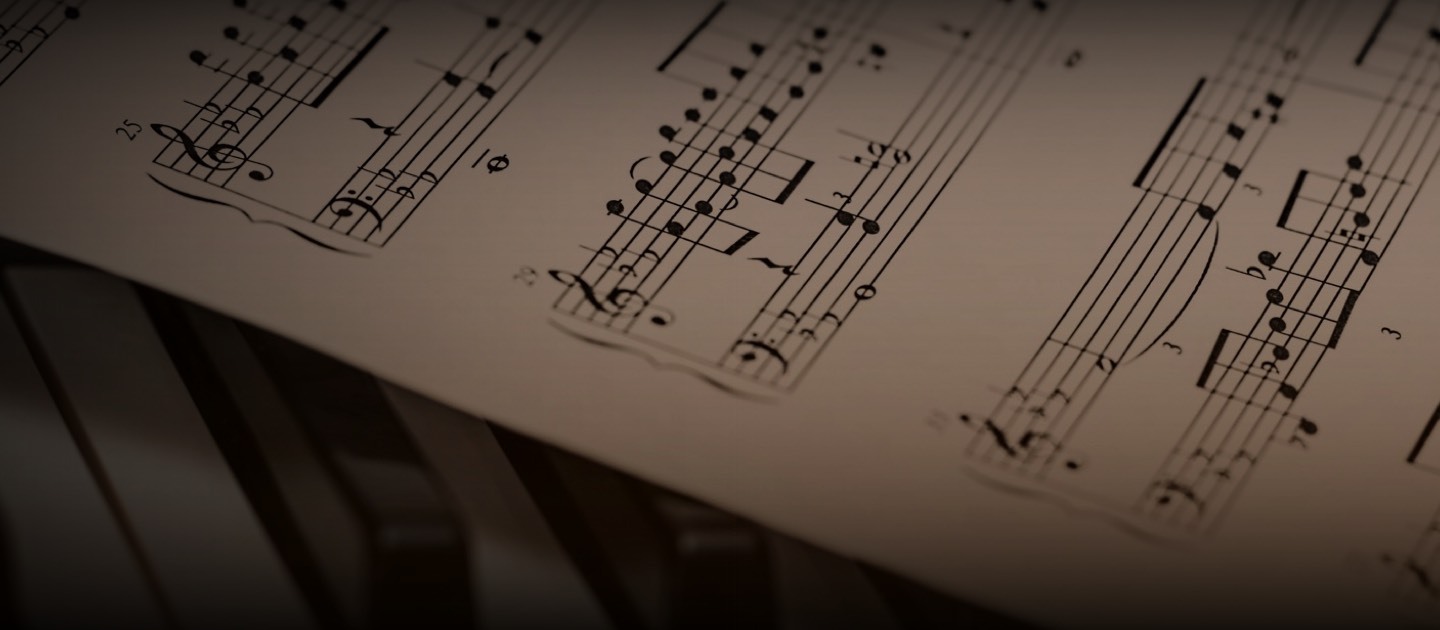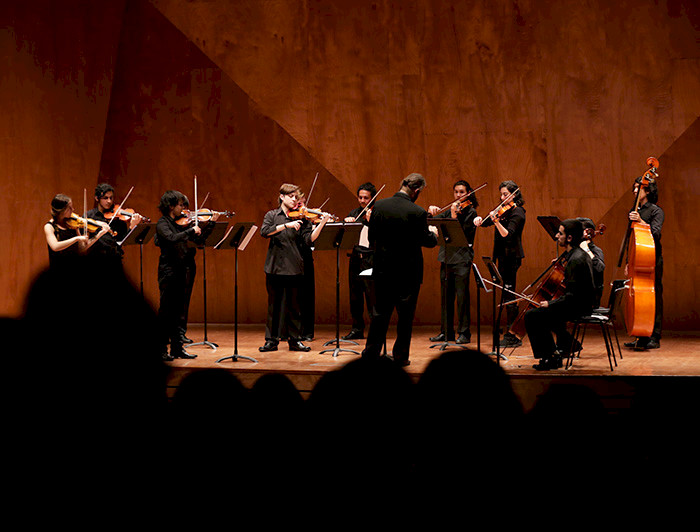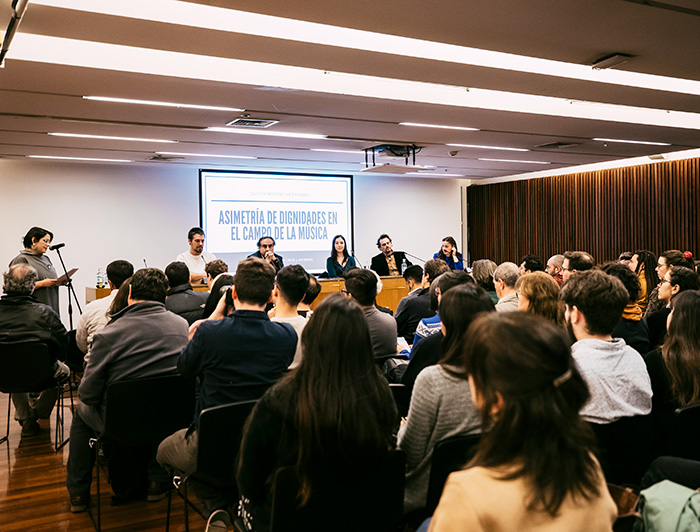
How Popular is Classical Music in Chile?
Led by UC Chile, the Music and Heritage Research Ring (Animupa) Project brings together four universities in an effort to study classical or art music as a cultural practice and form of heritage from a multidisciplinary perspective. The project seeks to contribute to the design of public and cultural policies in the country.

photo_camera The Animupa research project sheds light on the significance of classical or art music in the cultural and social progress of the nation, emphasizing its role as a living practice embraced by diverse communities and contributing to a fresh perspective on heritage. (Photo: Orquesta InterFacultades UC Chile / César Cortés)
In Chile, a prevalent prejudice suggests that classical or select music is a cultural practice that fails to reflect contemporary experiences and remains out of reach for most of the population. This is further exacerbated by the precarious state in which this genre of music currently exists in our country, demanding immediate investment and human resources.
According to Rodrigo Cadiz, a faculty member from the Institute of Music and the School of Engineering: "Performers have to study for at least ten years, and composers and musicologists require master's and doctoral-level training. Many music groups in Chile work under precarious conditions, and there is no national culture of commissions or donations. Moreover, state funding for classical music is insufficient compared to other genres."
Ironically, classical music in our country has a strong historical tradition compared to other art forms. The Metropolitan Cathedral of Santiago houses a vast collection of scores from the colonial era and boasts an ensemble of skilled musicians in its orchestra and choir. Established in 1850, the National Conservatory of Music is the second oldest in Latin America, preceded only by the conservatory in Rio de Janeiro. Opening its doors in 1857, the Municipal Theater of Santiago stands as one of the region's oldest theaters, preserving its historical significance and still hosting performances today.
Moreover, there is a continuous tradition of chamber music performances, dating back to at least the 1880s, and orchestral music performances since the 1920s. The country also has a long history of community orchestras and choirs that perform classical music.
Today, hundreds of classical music concerts are offered each year, ranging from early music to electroacoustic music. Furthermore, Chilean composers annually produce a multitude of art music compositions, performed on both national and international stages.
There are also around 300 orchestras in the country, including youth and professional orchestras, spread across different regions. Notable examples include the Teatro del Lago in Frutillar and the Concepción Symphony Orchestra. However, the majority of these orchestras are concentrated in the Metropolitan Region (according to information from Animupa).
Living Practice
Learn More about the Animupa Music and Heritage Research Project.
The objective of the Animupa Music and Heritage Research Project funded by the National Agency for Research and Development of Chile (ANID, as per its spanish acronym), under the Ministry of Science, Technology, Knowledge, and Innovation is to explore Chilean classical music from a contemporary heritage standpoint. It aims to highlight the significance of classical music as a multifaceted network involving various stakeholders that contributes to the social and cultural progress of the country. This project recognizes classical music as a living tradition nurtured by diverse communities.
Historically, research on art music has focused on the study of scores and composers' biographies. However, this project aims to pay attention to the meanings of music as a cultural practice.
Its purpose is to highlight the relevance of this type of music as part of the cultural and social development of the country—a living practice cultivated by different communities that constitutes a renewed understanding of heritage.
The director of the Animupa project, Rodrigo Cádiz, hopes the project's results can have an impact beyond the academic realm and influence public cultural policies in Chile, directing the field of art music towards heritage as a living practice. In fact, one of its goals is to create an observatory of cultural practices, focusing on classical music in the country.
Art or classical music, like any other musical practice, is made possible through the interaction, collaboration, and work of various agents, both human and non-human. Beyond composers and performers, this team asserts that a broad corpus of stakeholders should be considered, including entrepreneurs, audiences, institutions, academies, conservatories, guilds, community groups, among others. This approach will allow for the observation of networks of representation, association, and values associated with the living heritage of these musical practices in today's Chile.
“This research project will create an unprecedented space for multidisciplinary collaboration among musicologists, composers, and ethnomusicologists," said Carolina Gainza, the Undersecretary of Science, Technology, Knowledge, and Innovation, during the launch of Animupa on June 1st at the GAM Cultural Center.
New Perspective

Animupa is based on collaborative and diverse efforts, bringing together researchers from four Chilean universities, both from Santiago and regional areas: UC Chile, Universidad Alberto Hurtado, Universidad de Playa Ancha and Universidad Austral de Chile.
The team has defined a goal for each of the three years of the project:
- To establish and characterize cultural practices related to Chilean classical music in the light of updated heritage studies.
- To analyze the relationships between classical music, place, and identity in the context of the current state of select music in Chile.
- To explore the heritage dimensions of art music as a dynamic and living cultural practice shaped by a complex network of stakeholders, including practice-based artistic research.
In addition to the research, Animupa will organize a series of open seminars on various topics of interest: Chilean classical music (July), forgotten classical musicians (August), archives preserving the national music heritage in Chile (September), artistic practice as research and heritage (October), and regional archives (November).
The project also aims to incorporate and educate undergraduate and postgraduate students in this field of study. In their own words: "This is a project that aims to create a strong research community with a renewed and fresh perspective, not only in art music but also in many other areas of the humanities based on novel heritage theories."
- Rodrigo Cádiz, composer and electrical engineer, professor at the Institute of Music and the UC Chile School of Engineering.
- José Manuel Izquierdo, musicologist and faculty member of the UC Institute of Music.
- Daniela Fugellie, director of the Institute of Music of the Universidad Alberto Hurtado (UAH).
- Eileen Karmy, socio-musicologist and associate professor at the Universidad Alberto Hurtado (UPLA).
- René Silva, composer and professor at Universidad Austral de Chile (UACH).
- Nayive Ananías, journalist, master in Latin American Musicology UAH and UC Doctor of Arts with a specialty in Music.
- Louis Leclerc, a data consultant and research engineer specializing in Digital Humanities.
- Pablo Soto, classical guitarist and researcher.


